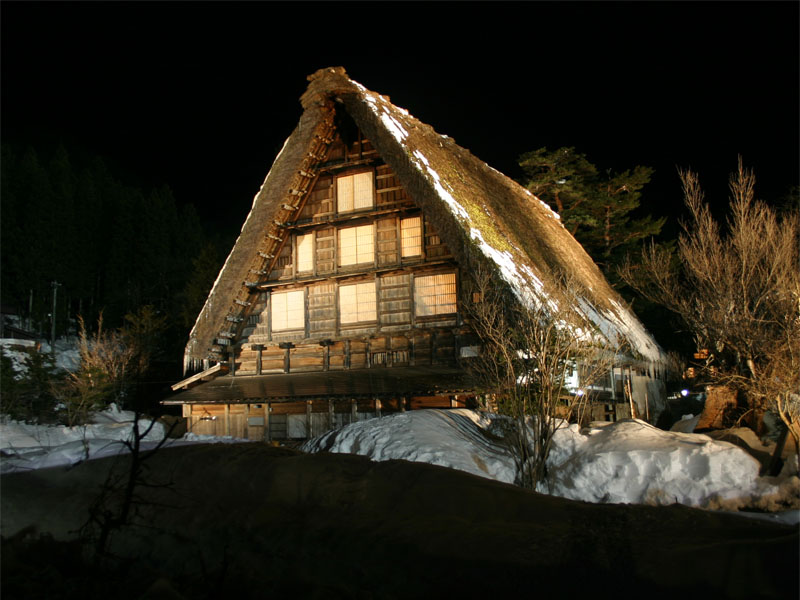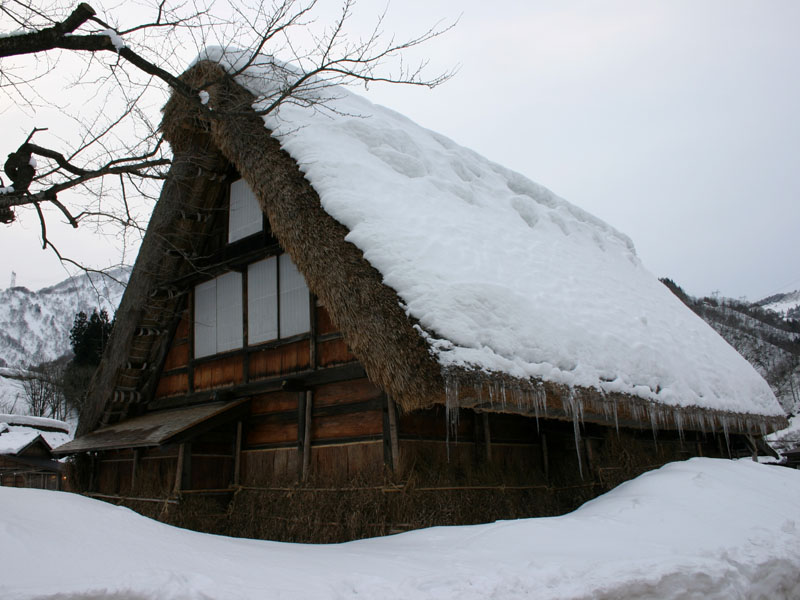Shirakawa-go, Gifu
I’ve always been captivated by the dichotomy between Japan’s bustling urban centers and its serene, historical villages. Among these, Shirakawago in Gifu Prefecture and Gokayama in Toyama are particularly interesting. A few hours away from the urban sprawl of Nagoya, it offers a stark yet refreshing contrast with its traditional landscape and a step back into a time where nature’s ebb and flow dictate the rhythm of life.
The journey from Nagoya to Shirakawago is a transformative experience. Leaving behind the city’s skyscrapers, the path winds through lush green mountains and crystal-clear rivers, leading to a tranquil village that feels almost ethereal. Shirakawago, nestled between the remote mountains above the Shogawa River Valley, is a world unto itself, a UNESCO World Heritage Site known for its striking Gassho-zukuri farmhouses.
These Gassho-zukuri houses, with their steep thatched roofs resembling hands clasped in prayer, are architectural marvels over 250 years old. They symbolize the ingenuity of past generations, built to withstand heavy snowfalls without a single nail. Many of these houses now serve as museums, guesthouses, and restaurants, allowing an intimate experience of the village’s rich history and culture.
Staying overnight in a Gassho-zukuri farmhouse is a humbling experience, contrasting sharply with the contemporary comforts of Nagoya. The locals’ hospitality and the rustic charm of the accommodations provide a deep dive into Japan’s rural lifestyle. These farmhouses also have practical uses; their spacious attic areas were historically used for cultivating silkworms, reflecting the self-sufficiency of the villagers.
Shirakawago’s beauty extends beyond its architecture. The village is a canvas of changing seasons – from the lush greenery of summer, the fiery hues of autumn leaves, to the pristine whites of winter snow. The winter season, in particular, is magical, with evening illuminations casting a fairy-tale glow on the snow-covered roofs.
The culinary journey here is as rich as its visual splendor. Local restaurants serve traditional Hida cuisine prepared with fresh, regional ingredients. Tasting homemade soba noodles and Hida beef is essential for any culinary enthusiast.
The village of Ogamichi is the most accessible and popular with tourists, offering various lodging options, including family-run minshuku (guesthouses). Staying in these traditional tatami rooms and dining on meals cooked on open ‘iori’ fireplaces is like stepping back in time.
For those seeking an even more secluded experience, Gokayama, a bit more remote and best approached by car, offers an equally enchanting escape. Here, you can immerse yourself in the untouched natural beauty and unique culture that has evolved in isolation.
Shirakawago is not just a destination; it’s a journey through Japan’s heart, connecting the vibrant urban life of cities like Nagoya to the tranquil, timeless beauty of rural Japan. Whether you’re a history buff, nature lover, or simply seeking peace, Shirakawago is a testament to the enduring charm of Japan’s rich heritage and natural splendor. It’s a reminder of the harmonious coexistence of past and present and the importance of preserving cultural legacies.
Shirakawa-go, Gifu
With bus lines from Takayama and Nagoya, the village of Ogamichi is the easiest to access and is most popular with tourists. However, this does mean that finding minshuku is more difficult.
Where: Ogimachi, Shirakawa, Ono District, Gifu 501-5627 (map)
For further information, check out the Shirakawa-go tourism websites here or here.
Gokayama, Toyama
Gokayama is a region in the Nanto city of Toyama Prefecture, Japan, known for its traditional gassho-zukuri farmhouses, much like those found at Shirakawago in neighboring Gifu Prefecture. This area, mainly the villages of Ainokura and Suganuma, shares its UNESCO World Heritage Site status with Shirakawago, which is recognized for its well-preserved historical buildings and the unique cultural landscape they create.
Key Features of Gokayama:
- Gassho-zukuri Architecture: The term “gassho-zukuri” refers to a style of farmhouse with a steep thatched roof, resembling the shape of hands in prayer (“gassho”). These houses are designed to withstand the heavy snowfall typical in the region. The architectural style is visually stunning and practical, allowing large attic spaces for activities like silk cultivation.
- Historical and Cultural Significance: The Gokayama area, particularly Ainokura, is renowned for preserving traditional Japanese culture and practices. The village appears frozen in time, offering a glimpse into the rural life of Japan several centuries ago.
- Ainokura Village: Among the villages in Gokayama, Ainokura is perhaps the most famous. It is smaller and less commercialized than Shirakawago, providing a more intimate and authentic experience of traditional rural Japan. The village is home to about 20 well-preserved gassho-zukuri houses, some over 250 years old.
- Cultural Experiences: Visitors to Gokayama can immerse themselves in various cultural experiences, such as observing or participating in traditional crafts, including washi (Japanese paper) making, and experiencing local folk music and dances.
- Natural Beauty: Gokayama is set amidst the picturesque landscapes of the Toyama Prefecture, with mountains, rivers, and lush greenery surrounding the historic villages. The change in seasons brings distinct beauty to the area, from vibrant green summers to snowy white winters.
- Accommodation: Similar to Shirakawago, some gassho-zukuri houses in Ainokura have been converted into minshuku, traditional Japanese guesthouses where visitors can stay and enjoy homemade local cuisine.
- Accessibility: Gokayama is less accessible than Shirakawago, making it a quieter and more secluded destination. Visitors typically reach the area by car or bus. Its relatively remote location contributes to its preserved, tranquil atmosphere.
Gokayama, specifically Ainokura, offers an escape to a world where traditional Japanese culture and architecture are preserved in their most authentic form. It’s an ideal destination for those looking to experience the rustic charm and peacefulness of historical rural Japan, away from the more tourist-centric locations.
Gokayama is a little more remote, and you are advised to approach by car rather than public transport.
Gokayama, Toyama
Where: Gokayama, Ainokura Nanto, Toyama 939-1915 (map)
For further information, check out the Shirakawa-go tourism websites here or here.
Photo by Yosemite, CC BY-SA 3.0, via Wikimedia Commons
Photo by Yosemite, CC BY-SA 3.0, via Wikimedia Commons


Pingback: Takayama City - Like Nagoya